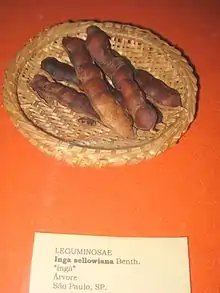Inga sellowiana
Inga sellowiana is an endangered species[1] of legume in the family Fabaceae, endemic to Brazil. It is an evergreen, perennial shrub or small tree, 1–8 metres (3.3–26.2 ft) in height.[2] Common names include ingá mirim, ingá ferro, ingá xixica and ingá xixi.[2]
| Inga sellowiana | |
|---|---|
 | |
| Scientific classification | |
| Kingdom: | |
| (unranked): | |
| (unranked): | |
| (unranked): | |
| Order: | |
| Family: | |
| Genus: | |
| Species: | I. sellowiana |
| Binomial name | |
| Inga sellowiana | |
It is found only in Brazil, specifically in the Southeast (São Paulo, Rio de Janeiro) and South (Paraná, Santa Catarina) Regions.[3][4] It has pentamerous white flowers which bloom from November through March, and from May through June.[2]
Etymology
The genus' name Inga originates from the Tupi word in-gá meaning "soaked".[5] The species was named after Friedrich Sellow, a major collector of Brazilian flora.
References
- World Conservation Monitoring Centre (1998). "Inga sellowiana". IUCN Red List of Threatened Species. 1998: e.T38238A10107331. doi:10.2305/IUCN.UK.1998.RLTS.T38238A10107331.en. Archived from the original on 2 June 2018. Retrieved 16 December 2017.|date=March 2019}}
- "Brazilian Flora Checklist - Inga sellowiana Benth". Archived from the original on 13 March 2019. Retrieved 13 March 2019.
- Maçaneiro, João Paulo de (7 March 2013). "Flora Digital do Rio Grande do Sul e de Santa Catarina: Inga sellowiana". Federal University of Rio Grande do Sul. Archived from the original on 13 March 2019.
- Maçaneiro, João Paulo de (7 March 2013). "Flora Digital do Rio Grande do Sul e de Santa Catarina: Inga sellowiana". Federal University of Rio Grande do Sul. Archived from the original on 13 March 2019.
- FERREIRA, A. B. H. Novo Dicionário da Língua Portuguesa. Segunda edição. Rio de Janeiro: Nova Fronteira, 1986. pp.945-946
This article is issued from Wikipedia. The text is licensed under Creative Commons - Attribution - Sharealike. Additional terms may apply for the media files.
